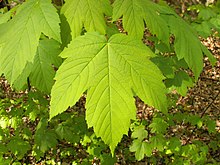Evolutionary History and Biology:
– Acer is closely related to Dipteronia.
– The oldest known fossils of Acer date back to around 60 million years ago.
– Fossils of Acer in Europe are from around 38-34 million years ago.
– Molecular studies suggest a Late Paleocene origin for Acer.
– 54 maple species are under threat of extinction.
– Most maples are trees or shrubs.
– Maples are deciduous, but some are evergreen.
– Maple flowers are regular and pentamerous.
– Maple roots inhibit the growth of other vegetation.
– Maple fruits, called samaras, have distinctive winged structures.
– Maple leaves are food for Lepidoptera larvae.
– Aphids are common sap-feeders on maples.
– Asian long-horned beetles have caused destruction to maples.
– Maples are susceptible to fungal diseases like Verticillium wilt and sooty bark disease.
– Tar spot and mildew can affect maple leaves in late summer.
Cultural and Symbolic Significance:
– The maple leaf is on the Canadian flag and coat of arms.
– Maple is the national tree of Canada.
– Maple leaves are part of Canadian Forces military regalia.
– The Toronto Maple Leafs is a Canadian ice hockey team.
– The maple leaf is a symbol of strength and endurance.
Uses and Commercial Applications:
– Maples are commonly grown in gardens for their autumn color.
– Maple syrup is made from the sap of some maple species.
– Maple seeds, called samaras, have unique winged structures for dispersal.
– Maple wood is used in furniture making and flooring.
– Maple leaves are used in the coat of arms of various regions.
– Maple trees are sources of syrup and wood.
– Maple wood is used for smoking food and making charcoal.
– Some maple species have valuable timber like Sugar maple.
– Maple wood is graded based on physical and aesthetic characteristics.
Cultivars and Bonsai:
– Japanese maple (Acer palmatum) has over 1,000 cultivars.
– Cultivars are propagated through asexual reproduction methods.
– Some delicate cultivars are grown in pots and remain small.
– Acer palmatum var. Kiyohime is a prized dwarf hybrid cultivar.
– Cultivars are selected for specific characteristics.
– Maples like Japanese maple are popular for bonsai.
– Techniques can encourage leaf reduction and ramification.
– Trident maple, Amur maple, and others are used for bonsai.
– Most maple species can be used for bonsai.
– Bonsai enthusiasts often choose maples for their art.
Tourism and Collections:
– Many maples have bright autumn foliage.
– Leaf-watching traditions exist in many countries.
– Sugar maple is the primary contributor to fall foliage season in North America.
– Japan has a tradition called momijigari for viewing changing maple colors.
– Korea also has a leaf-viewing activity called danpung-nori.
– Maple collections are found in gardens and arboreta worldwide.
– Esveld Aceretum in Netherlands is the largest collection.
– Notable collections include those at Wakehurst Place Garden.
– Harvard-owned Arnold Arboretum in Boston has a notable aceretum.
– Acer griseum is widely grown for its decorative bark.
Acer (/ˈeɪsər/ AY-sər) is a genus of trees and shrubs commonly known as maples. The genus is placed in the soapberry family, Sapindaceae, along with lychee and horse chestnut. There are approximately 132 species, most of which are native to Asia, with a number also appearing in Europe, northern Africa, and North America. Only one species, Acer laurinum, extends to the Southern Hemisphere. The type species of the genus is the sycamore maple, Acer pseudoplatanus, the most common maple species in Europe. Maples usually have easily recognizable palmate leaves (Acer negundo is an exception) and distinctive winged fruits. The closest relatives of the maples are the horse chestnuts. Maple syrup is made from the sap of some maple species. It is one of the most common genera of trees in Asia. Many maple species are grown in gardens where they are valued for their autumn colour.
| Maple Temporal range:
| |
|---|---|

| |
| Acer pseudoplatanus (sycamore maple) foliage | |
| Scientific classification | |
| Kingdom: | Plantae |
| Clade: | Tracheophytes |
| Clade: | Angiosperms |
| Clade: | Eudicots |
| Clade: | Rosids |
| Order: | Sapindales |
| Family: | Sapindaceae |
| Subfamily: | Hippocastanoideae |
| Genus: | Acer L. |
| Species | |
|
See either | |

| |
| Distribution | |
